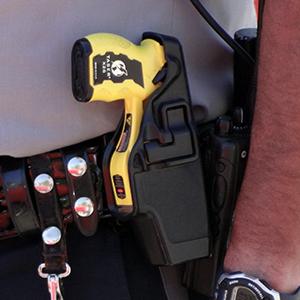Table of Contents
- Jamie Caetano’s Experience with Domestic Abuse and the Turning Point
- The Role of Stun Guns in Self-Defense and Personal Safety
- Legal and Ethical Considerations in Using Non-Lethal Weapons
- Practical Advice for Victims Seeking Effective and Safe Protection Methods
- Future Outlook
Jamie Caetano’s Experience with Domestic Abuse and the Turning Point
For years, Jamie Caetano endured a harrowing cycle of intimidation and violence at the hands of her partner. The abuse, both physical and emotional, left Jamie feeling isolated and powerless. Despite numerous attempts to seek help, she found that traditional support systems often failed to offer immediate protection. The fear of escalating violence loomed constantly, making everyday life a dangerous and unpredictable ordeal. It wasn’t until a particularly severe incident that Jamie realized she had to take control of her safety, marking a critical shift in her journey.
Her turning point came when Jamie decided to equip herself with a stun gun, a decision that empowered her to reclaim her autonomy. This tool provided her with a tangible means of defense and a renewed sense of confidence. Key factors in this transformation included:
- Immediate safeguard: The stun gun offered instant, non-lethal protection, giving Jamie critical moments to escape threats.
- Psychological empowerment: Carrying the device restored her courage and diminished the pervasive fear that had controlled her.
- Increased awareness: Jamie became more proactive about personal safety, incorporating self-defense and emergency planning into her routine.
This decisive act not only helped Jamie survive but also sparked a broader conversation about self-defense tools for domestic abuse survivors, highlighting their potential role in personal safety strategies.
The Role of Stun Guns in Self-Defense and Personal Safety
Stun guns have emerged as critical tools in empowering individuals facing imminent threats, especially in scenarios where physical altercations or abuse occur. Jamie Caetano’s experience underscores the effectiveness of these devices in offering a non-lethal but immediate response to potential assailants. Designed to temporarily incapacitate an attacker through a high-voltage shock, stun guns disrupt muscle control, creating a valuable window for victims to escape and seek help. Key advantages of stun guns include:
- Portability: Easily carried in a purse or pocket, ensuring accessibility during emergencies.
- Ease of Use: Simple activation methods allow users of varying physical strength to operate effectively.
- Non-lethal Defense: Provides personal protection without the risks associated with firearms or blades.
In Jamie’s case, the stun gun was not only a deterrent but a vital lifeline that broke the cycle of abuse, demonstrating how these devices can shift the balance of power in dangerous situations. Their role extends beyond immediate defense-they act as psychological tools that boost confidence and preparedness, enabling individuals to regain control over their personal safety and autonomy.
Legal and Ethical Considerations in Using Non-Lethal Weapons
When considering the deployment of non-lethal weapons like stun guns, it is imperative to navigate a complex landscape of legal frameworks and ethical responsibilities. Legal statutes vary significantly across jurisdictions, with some regions imposing strict regulations on possession, use, and carry of these devices. Users must be fully informed of their local laws to ensure compliance and avoid unintended legal consequences. Moreover, law enforcement agencies and civilians alike are urged to prioritize proportionality and necessity when deploying non-lethal force, ensuring it serves as a last resort to prevent harm while respecting human rights.
Beyond legality, ethical considerations play a pivotal role in the responsible use of stun guns, especially in contexts of personal defense such as Jamie Caetano’s case. The moral imperative to protect oneself from abuse must be balanced against the potential physical and psychological impacts on the aggressor. Key principles include:
- Minimization of Harm: Ensuring that the application of the stun gun causes only temporary incapacitation without lasting injury.
- Accountability: Maintaining transparency and documentation of incidents where stun guns are used to promote trust and prevent misuse.
- Training and Awareness: Encouraging proper education on device operation and de-escalation techniques to enhance safety and efficacy.
By integrating these legal and ethical considerations, users like Jamie not only safeguard their well-being but also contribute to broader societal standards for the responsible use of non-lethal weapons.
Practical Advice for Victims Seeking Effective and Safe Protection Methods
When considering self-defense options, it’s crucial for victims to prioritize both effectiveness and personal safety. Jamie Caetano’s experience highlights the importance of choosing tools that are legal in your jurisdiction, easy to carry, and quick to deploy under stress. Tools like stun guns offer a non-lethal alternative, capable of temporarily incapacitating an aggressor without causing permanent harm. Before acquiring any device, individuals should take time to research local laws, attend training sessions, and practice handling the equipment to build confidence and ensure proper use in emergencies.
Beyond physical tools, victims are encouraged to develop a multi-layered safety plan, which can include:
- Informing trusted friends or family about their situation
- Establishing safe zones in the home or workplace
- Setting up quick-access emergency contacts on their phone
- Continuously updating personal awareness and situational alertness
This holistic approach, combined with strategic use of protection devices like stun guns, enhances the chance of avoiding harm while empowering victims to regain control over their safety.
Future Outlook
Jamie Caetano’s story sheds light on the urgent need for effective measures to protect individuals facing domestic abuse. Her decision to use a stun gun as a means of self-defense highlights both the challenges survivors encounter and the critical importance of accessible self-protection tools. As discussions around personal safety continue to evolve, Caetano’s experience serves as a powerful reminder of the resilience required to combat abuse and the ongoing necessity for supportive resources and legal frameworks that empower victims.Check Our Other Blogs
- StunGun – Your Trusted Source for Stun Guns, Laws, and Self-Defense Tips
- PepperSprayLaws – Your Trusted Resource for Pepper Spray Information
- StunGunLaws – Your Trusted Guide to Stun Gun Legality and Safety





